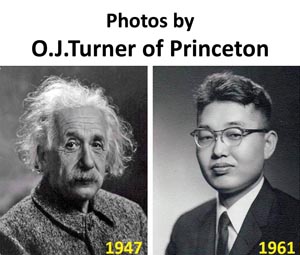Photos from the British Museum
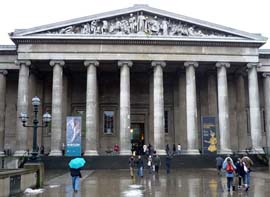
|
- In 1949, I learned that the stutue of Buddha was a product of Greek art.
When the Greek troops of Alexander the Great went to the Punjab area
(now Pakistan and Afghanistan), they had to face Indian troops mounted on
elephants. They were captured by Indian, but were allowed to practice
their Greek profession of making statues.
- They made their living by making statues for kings and noble
people in Gandara (now Afghanistan). Initially, like Islamic religion,
Buddhism did not allow idol worships. However, one of the Gandara
kings adopted Buddhism as his state state religion and encouraged
his people to come to the temple to worship. In order to enforce
his policy, he needed a statue of Buddha, and he hired those Greek
sculptors. I learned this in my high-school history class, but I was
always interested seeing some historical evidence.
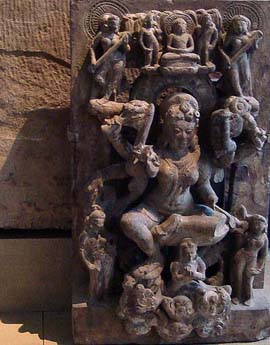
- In 1982, while flying to London from Baltimore, a person sitting
next to me told me the British Museum contains many ancient items
from India, Pakistan, and Afghanistan. Then I thought I could see
the early Buddha statues by built by those Greek sculptors, and I
went directly to the British Museum after checking into my
hotel in London. Indeed, those early statues of Buddha looked
like exactly like Greek sculptures. It was one of the happiest days
in my life. It was an experimental confirmation of my theory.
Since then, I went there often. Let us look at some photos.
- Gandara Sculpture. When I went in 2008, the original Greek-style Buddhas I saw in 1982 were gone. However, there were some Gandara artworks, heavily influenced by Greek sculpture.
- This engraving is telling some story in Buddhism, but is a Greek-style art work.
- Another Gandara Artwork. Gandara's capital city is believed to be Kabul, but the city name "Kandahar" sounds strikingly similar.
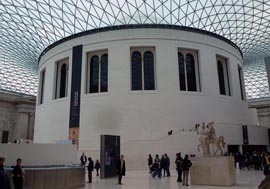
- Entrance to the Museum. The
closest Underground Station is Holborn or Tottenham Court Road.
- The Main Lobby consists of the entire ground floor. There are always school children who came here as part of their study program.
- Egyptian Lion in the main lobby.
- Young Roman Noble Man near the ticket counter.
- Exhibition Hall. This cylindrical tower is used for special exhibitions. This tower used be the library, and Karl Marx wrote his books here.
- Cafeteria and Resting Place. They are needed because the building is so extensive.
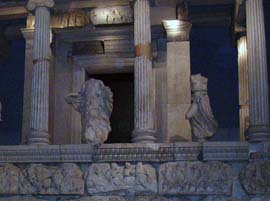
- The Greek Section
is the most important component of this Museum.
- Parthenon Temple. This is
a reconstruction of the East Pediment.
Here is the original design. - Socrates. It was great to have a photo with this man.
- Venus. This Venus statue is of right size for me (2004).
- Happy to meet her again in 2012. She was still there, and I became older.
- Greek Lady with life. She works for the Greek section of this library. She was very kind to me.
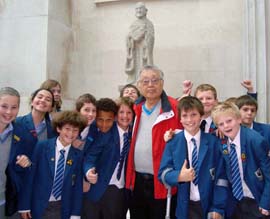
- Parthenon Temple. This is
a reconstruction of the East Pediment.
- Interesting People.
It is highly educational to see those historical items.
However, nothing is more interesting that talking to the
objects that can talk back. There are always middle
school students who came to learn, like myself.
- College Students from Japan. It was a pleasure to talk about their country.
- Young People from Korea. They were Samsung employees and are very proud of their company. Recently, the Museum arranged a special room for Korean arts and life style. It is safe to assume that Samsung had to contributed some amount of money for this arrangement.
- High School Students from Spain.
- Italian student from Padua. She came to see the origin of the Hajj.
Hadrian Exhibition
In 2008, there was an exhibition on Emperor Hadrian. I made a special trip to London to see this exhibition. I did not see "No Photo" sign at the exhibition, and I took many photos there. However, I choose not to post them on this webpage. I have many Hadrian photos taken elsewhere, and I can list them here.- During the exhibition, there were many items outside the exhibition hall. I assume
I was allowed to photograph them.
- Hadrian at the entrance to the exhibition hall.
- Hadrian's Wall in Scottland, from a billbord outside the Museum building.
- Castel Sant'Angelo was built as the mausoleum of Hadrian during the period 135 - 139. The construction started three years before his death. This cylindrical structure is near the Vatican City in Rome. A large image of this Castle was shown in front of the Museum building.
- Tivoli Villa, 30 kilometers east of Rome. This palace was built by Emperor Tibur (14 - 37 AD), but Hadrian expanded it, and he used this place as his White House plus his retreat places. This photo is from one of the billboard outside the building. There was a model of this Tivoli palace in the exihibition.

Greek and Roman technologies 

- The Pantheon in Rome was built by Emperor Hadrian in 126 AD. Its purpose was to entertian
all gods known to Romans. Its architecture combines the Roman dome and Greek columns.
This tradition continued until 1943 when the Jefferson memorial was built in
Washington, DC, U.S.A., and will continue. Let us look at some photos of this
historic contruction.
- Entrance and the Obelisk. The Obelisk came from the Egyptian tradition. The entrance style came from Greece. What is inside?
- A huge ceiling without supporting poles. Romans developed this technology. The opening at the top was for bringing in sun light from the sky. Romans did not have electric lights.
- Each block on this ceiling is to
represent one of the numerous Roman gods.
- The heavy Roman roof is supported by thik Roman walls. Is it possible to replace those walls by Greek columns?
- Thomas Jefferson Memorial in Washington,
DC, U.S.A, inherits this spirit of combining Greek and Roman inventions.
Thomas Jefferson was quite fond of this Italian tradition, and built
his own house according
to the idea originated by Emperor Hadian.
- Inside, the Pantheon is a Christian museum. The museum items include
- Christmas set up was still there during the first week of Janauary (2009).
- Tourists are always there. I had a photo with Japanese students who came to Italy during their winter break.


- Castel Sant'Angelo was built for Emperor Hadrian's mausoleum, but it served
many different purposes depending on the political climates of Rome. This
castle is located on the northern bank of the Tiber River. It is about 2km
east of St. Peter's Basilica.
- The castle and the Tiber Bridge seen from another bridge sounth of the Castle.
- A close-up view of the castle, seen from the southern bank of the Tiber River.
- Angel at the top. The Italian word "angelo" means "angel" in English. The Castle is thus called "Castle of Angel."
- Pope's secret walkway connecting
this Castle with the Pope's resdidence in Varican.
- Porous Bottle in this Castle. There were no refrigerators until the 20th century. Water was cooled by porous bottles. When a small amount of water comes out through the porous wall, it evaporates quickly and takes away heat. This technology was developed in ancient Egypt and used by Greeks, Romans.
- St. Peter's Basilica seen from this Castle.
- The monument of Vitttorio Emanuel II seen from this Castle.

- Bust of Emperor Hadrian in
the Vatican Museum.
- Hadrian in the Louvre Museum in Paris.
- Hadrian Arch in Athens (Greece).
- Hadrian Library in Athens. Hadrian loved Greek arts, Greek literature, Greek gods, and Greek everything. He built this libary in 132 AD.
- Statue of Hadrian at the Agora Market Place in Athens.
- I have many more photos from the British Museum. I will post them when I have time. Please come again.
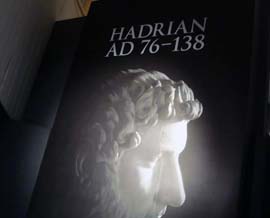
|
|
